Welcome to my blog article on the various uses and benefits of madder root. Madder root is a fascinating plant that has been valued for centuries for its versatility and natural properties. From being used as a vibrant natural dye to offering potential medicinal benefits, madder root has found its way into various industries and daily routines. In this article, we will explore the history, applications, and precautions associated with madder root. So, let’s dive in!
Key Takeaways:
- Madder root has been used for centuries as a natural dye, particularly in the textile industry.
- It contains powerful compounds such as alizarin and purpurin, giving it its vibrant red color.
- Madder root has potential medicinal properties, including anti-inflammatory and wound healing effects.
- It is used in culinary applications as a natural food coloring, but should be used sparingly.
- Madder root is increasingly used in personal care products, such as skincare and hair care formulations.
What is Madder Root?
Madder root, also known as Rubia tinctorum, is a plant with a long history of being used as a natural dye and medicinal herb. Derived from the roots of the madder plant, this versatile herb is renowned for its vibrant red color and contains powerful compounds that contribute to its dyeing properties and potential health benefits.
Throughout centuries, madder root has been cultivated and utilized in various regions, including Turkey, Iran, and India. Its rich cultural heritage and natural properties have made it a valuable resource in various industries, such as textiles, personal care, and traditional medicine.
The deep red hue of madder root dye, known as “Turkey red,” revolutionized the textile industry. With its ability to dye fabrics such as silk, wool, cotton, and leather, madder root played a significant role in creating colorful and durable textiles. Even to this day, madder root remains a popular choice for natural dyeing, preserving traditional techniques and sustainable practices.
“Madder root dye, known as ‘Turkey red,’ was highly prized and considered a closely guarded secret.”
Furthermore, madder root is not only valued for its color but also for its potential medicinal benefits. The root contains compounds such as alizarin and purpurin, which possess anti-inflammatory properties and are believed to aid in joint health, reduce redness and swelling, and promote wound healing.
Madder root has even found its place in the culinary world, where it is used as a natural food coloring. Chefs and home cooks alike rely on madder root powder or extract to add a vibrant red hue to various dishes, including desserts, beverages, and savory creations.
In recent times, madder root has gained popularity in personal care products. It is incorporated into skincare formulations, such as creams, lotions, and serums, for its antioxidant and anti-inflammatory effects on the skin. Additionally, madder root is utilized in natural hair dyes, offering a plant-based alternative to synthetic colorants.
Moreover, madder root’s versatility goes beyond textiles and personal care. It can be utilized in various DIY projects, such as natural dyeing crafts and homemade bath products. Additionally, some use madder root for dyeing Easter eggs or creating natural watercolor paints.
When selecting madder root, it is crucial to choose high-quality sources and ensure organic and sustainably sourced options. Storing madder root in an airtight container, away from direct sunlight and moisture, helps maintain its potency and quality.
In conclusion, madder root, with its natural dyeing properties and potential health benefits, holds a significant place in various industries and daily routines. From the vibrant colors it imparts to textiles to the potential medicinal applications and culinary uses, madder root continues to be a valuable and versatile herb.
Historical Uses of Madder Root

Madder root has a fascinating history as a natural dye, and its use in the textile industry spans centuries. The deep and captivating red color derived from madder root, known as Turkey red, was highly coveted and considered a well-kept secret in certain regions. The art of dyeing with madder root has been passed down through generations, preserving traditional techniques and sustainable practices in the textile industry.
The dyeing process with madder root involves extracting the vivid red pigments from the roots of the madder plant. These pigments, such as alizarin and purpurin, are responsible for the rich hues that can be achieved when dyeing fabrics.
Madder root was used to dye a variety of textiles, including silk, wool, cotton, and leather. The dyeing process was meticulous and required expertise to achieve consistent and long-lasting colors. The resulting shades of red ranged from vibrant and intense to softer, earthy tones.
Table: Madder Root Dyes for Different Fabrics
| Fabric | Color |
|---|---|
| Silk | Vibrant red |
| Wool | Deep crimson |
| Cotton | Warm terracotta |
| Leather | Earthy maroon |
The use of madder root as a natural dye continues to this day, as artisans and designers appreciate its heritage and the rich colors it produces. It represents a sustainable and environmentally friendly alternative to synthetic dyes, aligning with the growing interest in eco-conscious practices in the textile industry.
The historical significance of madder root in the textile industry cannot be overstated. Its extraordinary red hues, intricately achieved through traditional dyeing methods, have adorned fabrics for centuries.
Madder root not only brings color to textiles but also tells a story of cultural heritage and craftsmanship. Its historical uses in the textile industry have left an indelible mark on the rich tapestry of human creativity and have contributed to the enduring beauty and allure of naturally dyed fabrics.
Medicinal Properties of Madder Root
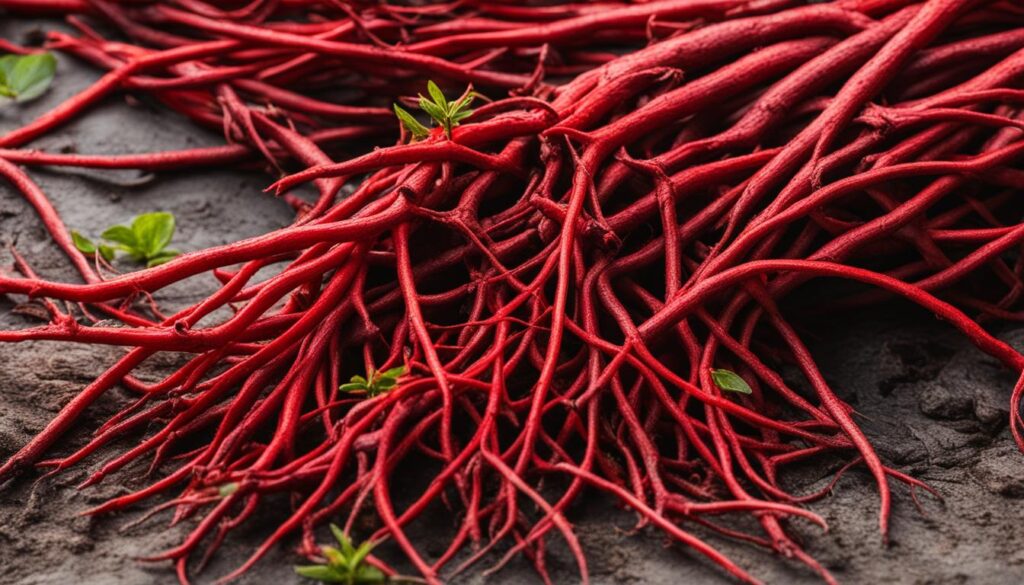
Madder root not only serves as a natural dye but also offers a host of medicinal benefits that have been recognized for centuries. The root is known for its anti-inflammatory properties, making it a valuable tool for relieving joint pain, inflammation, and swelling associated with conditions like arthritis. Through its diuretic effects, madder root promotes healthy urine flow, facilitating the cleansing of the body and supporting optimal kidney function. Additionally, madder root has been used topically for wound healing, as it aids in the regeneration of skin tissues and promotes faster recovery.
When used for medicinal purposes, it is crucial to consult with a healthcare professional to determine the appropriate dosage and application method based on individual needs and health conditions.
Explore the potential medicinal benefits of madder root:
“Madder root offers a wide range of anti-inflammatory, diuretic, and wound healing properties, making it a versatile natural remedy.”
Unlock the healing potential of madder root by incorporating it into your wellness routine!
| Medicinal Benefits of Madder Root | Application Methods |
|---|---|
| Anti-inflammatory properties | Dosage instructions for oral use (capsules or tinctures) are available. Topical application as a cream or oil to be applied directly on affected areas. |
| Diuretic effects | Consultation with a healthcare professional is recommended to determine the appropriate dosage for promoting urination and cleansing the body. |
| Wound healing | Topical application of madder root as a cream or infused into skincare products to support the healing process of skin conditions and wounds. |
Culinary Uses of Madder Root
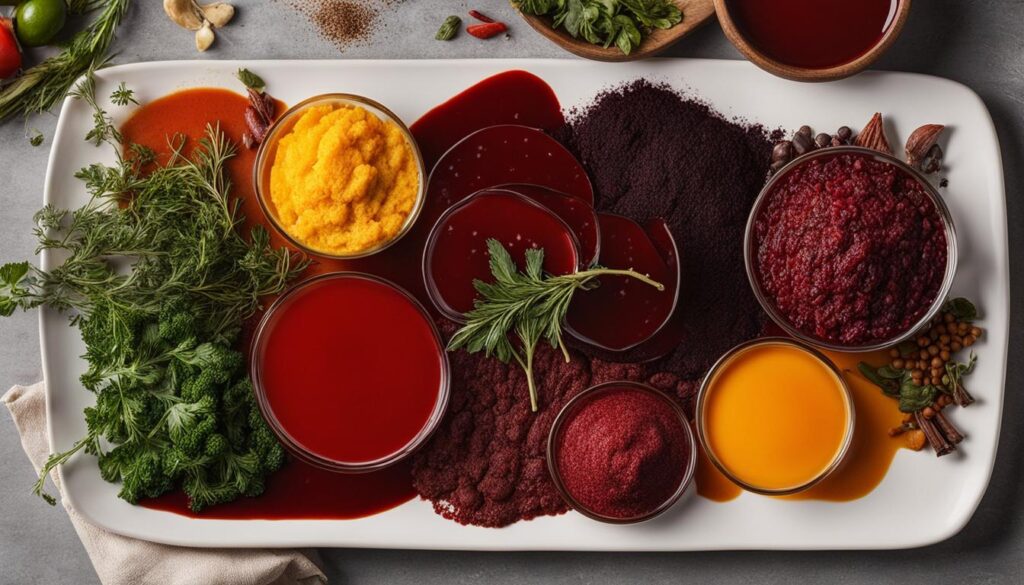
Madder root, with its vibrant red color, has made its way into the culinary world, offering natural food coloring options for various dishes and beverages. Chefs and home cooks alike have embraced madder root powder or extract for creating visually stunning culinary creations, ranging from desserts and drinks to even savory dishes.
The rich red hue of madder root adds a touch of uniqueness and elegance to culinary creations, making them visually appealing. Whether it’s a vibrant red cake, a beautifully colored cocktail, or a savory sauce with a hint of red, madder root enhances both the taste and appearance of dishes.
When using madder root in culinary applications, it’s important to exercise caution and use it sparingly. While madder root is considered safe in moderation, excessive consumption may have potential side effects due to its active compounds. Therefore, it’s advisable to follow recommended quantities and consult professional guidance when experimenting with madder root in recipes.
Recipes Utilizing Madder Root
- Strawberry Madder Root Smoothie
- Madder Root-infused Red Velvet Cupcakes
- Beet and Madder Root Salad with Balsamic Dressing
- Madder Root Risotto with Roasted Vegetables
- Raspberry Madder Root Lemonade
These recipes showcase the versatility of madder root in different culinary creations, from refreshing beverages to indulgent desserts and even savory dishes. As with any ingredient, it’s essential to follow recipe instructions and creatively explore madder root’s potential in your culinary endeavors.
“Incorporating madder root into my recipes has allowed me to create visually stunning dishes that simply amaze my guests. Its natural red coloring adds that extra special touch to any culinary creation, taking it to a whole new level.” – Chef Emily Thompson
Personal Care Products and Madder Root
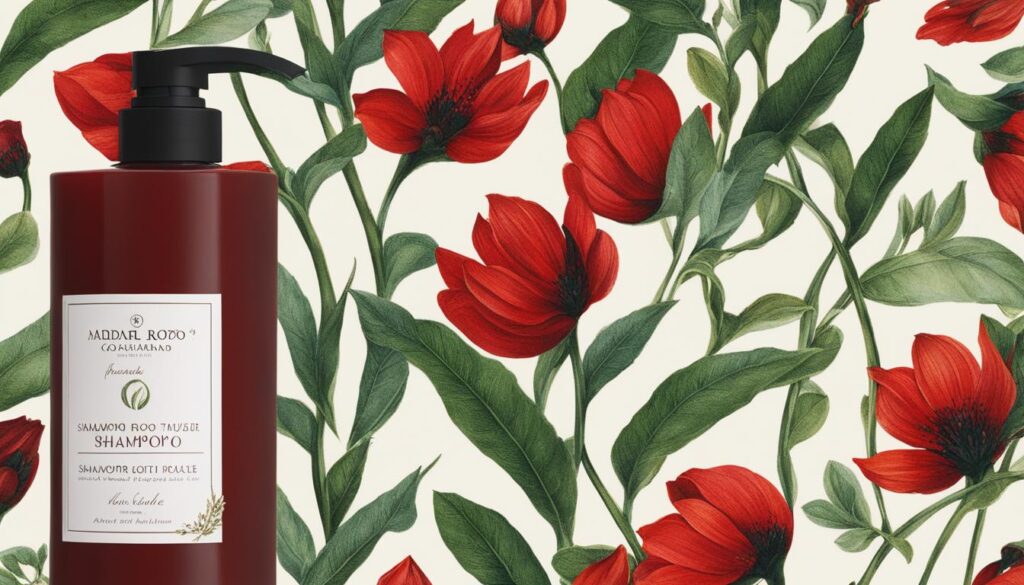
Madder root is becoming increasingly popular in the beauty industry, thanks to its natural properties and numerous benefits. It is now a common ingredient in various personal care products, including skincare and hair care products. The use of madder root in these products offers a holistic approach to beauty, harnessing the power of nature to enhance our skin and hair.
The Benefits of Madder Root in Skincare
In skincare products, such as creams, lotions, and serums, madder root provides antioxidant and anti-inflammatory effects. These properties can help protect and nourish the skin, reducing inflammation and supporting a healthy complexion. By incorporating madder root into your skincare routine, you can experience the benefits of this natural ingredient in promoting overall skin health.
Madder Root in Hair Care
Madder root is also used in hair care products, particularly in natural hair dyes. Unlike synthetic dyes, which may contain harmful chemicals, madder root offers a gentle and plant-based alternative. It provides a natural and vibrant coloring effect while minimizing damage to the hair. By choosing hair care products infused with madder root extract, you can achieve beautiful, lustrous locks without compromising on your health or the environment.
To ensure the efficacy and safety of the personal care products you choose, it is crucial to opt for reputable brands that use high-quality madder root extract in their formulations. Look for products that prioritize natural ingredients and sustainable practices to further enhance the benefits of madder root in your beauty routine.
| Benefits of Madder Root in Personal Care Products | Product Types |
|---|---|
| Antioxidant and Anti-inflammatory Effects | Skincare: creams, lotions, serums |
| Gentle and Plant-based Alternative | Hair Care: natural hair dyes |
Madder root extract is a natural ingredient used in personal care products.
In conclusion, madder root is a valuable addition to personal care products, offering natural skincare and hair care benefits. By incorporating madder root-infused products into your beauty routine, you can enjoy the advantages of this plant-based ingredient while supporting sustainable and eco-friendly practices.
Household and Other Topical Uses of Madder Root
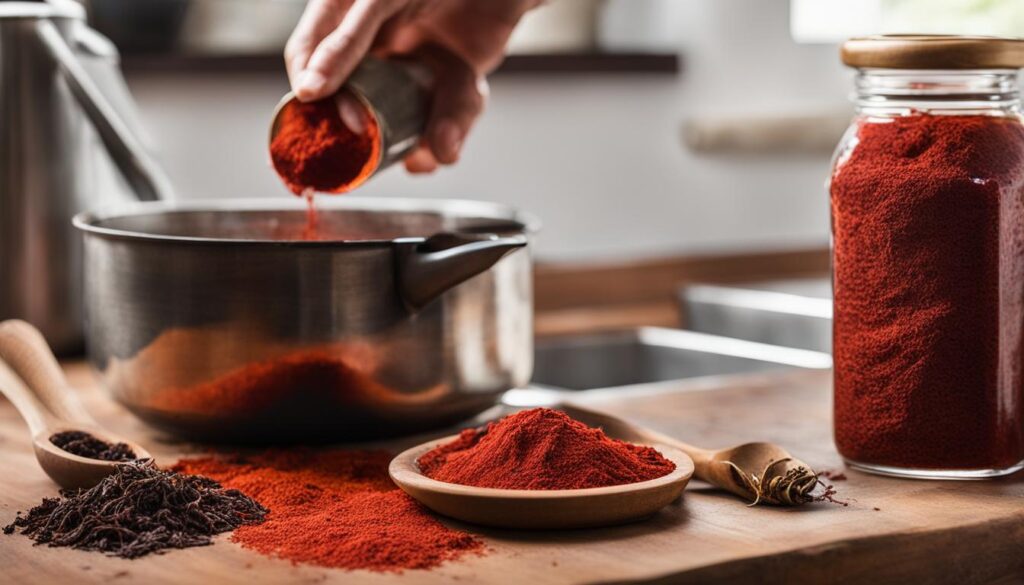
In addition to its uses in the textile industry, madder root can add a vibrant touch to various household applications and DIY projects. Its natural dyeing properties make it an excellent choice for those interested in eco-friendly and sustainable crafts.
Natural Dyeing Crafts
One popular way to incorporate madder root into household projects is by creating natural dyes for crafts and fabric dyeing. Whether you’re upcycling old garments or customizing new ones, madder root can help you achieve beautiful and unique colors. Experiment with different techniques and fabric types to create stunning designs.
“Madder root adds a touch of authenticity and sustainability to your crafting projects.”
Here’s a simple recipe to make a madder root dye:
- Prep the fabric by washing it thoroughly to remove any dirt or sizing agents.
- In a large pot, combine madder root powder and water in a 1:4 ratio.
- Bring the mixture to a simmer and let it cook for about an hour, allowing the dye to infuse.
- Add the fabric to the pot and gently stir it to ensure even color distribution.
- Simmer the fabric in the dye bath for approximately 30 minutes to an hour, depending on desired color intensity.
- Remove the fabric and rinse it under cold water until the water runs clear.
- Let the fabric air dry and enjoy your newly dyed creation!
Feel free to experiment with different ratios, dyeing times, and fabric types to achieve your desired results.
Topical Applications
Madder root can also be used in topical applications, adding a natural touch to your personal care routine. You can craft luxurious bath salts and bath bombs that not only provide a relaxing experience but also impart a beautiful color to your bathwater.
To make madder root bath salts, follow these simple steps:
- Mix Epsom salt, sea salt, and madder root powder in a bowl.
- Add a few drops of your favorite essential oils for a pleasant scent (optional).
- Transfer the mixture to an airtight container, such as a glass jar.
- When ready to use, add a few tablespoons of the bath salts to a warm bath and soak for a rejuvenating experience.
Madder root can also be used for unique DIY projects such as dyeing Easter eggs or creating natural watercolor paints. Let your creativity flow and explore the endless possibilities that madder root offers.
Now that you have a glimpse of the household and topical applications of madder root, let’s delve into its medicinal properties in the next section.
Benefits and Application Methods of Madder Root
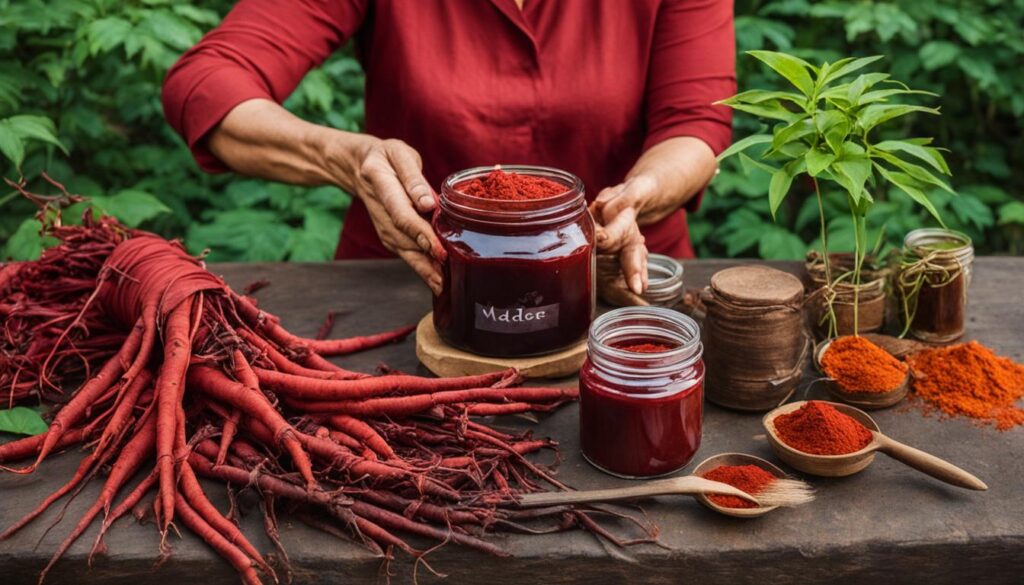
Madder root, with its vibrant red color, offers several potential benefits and is known for its diverse application methods. Whether used orally or topically, madder root has been recognized for its anti-inflammatory properties, support for reproductive health, and purifying effects on the blood and lymph nodes.
Oral Application
One way to reap the benefits of madder root is to use it orally. Capsules or tinctures containing madder root can be consumed to support overall health. These formulations enable the body to benefit from madder root’s anti-inflammatory properties and its potential to purify the blood and lymph nodes. To ensure safe and effective usage, it is important to follow the recommended dosage instructions and consult with a healthcare professional.
Topical Application
Madder root can also be applied topically, making it an excellent addition to skincare and wound healing routines. Formulations such as creams, oils, or skincare products infused with madder root can harness its antioxidant properties and aid in wound healing. The topical application of madder root offers a natural and plant-based alternative for those seeking the benefits of this potent herb for their skin. It is advised to follow the usage instructions provided by the product and consult with a dermatologist or skincare professional if needed.
When utilizing madder root for its medicinal properties, it is crucial to ensure proper usage, moderation, and consultation with healthcare professionals. The benefits of madder root can be experienced through its oral or topical application, providing individuals with a natural option to support their overall health and well-being.
Tips and Cautions for Using Madder Root
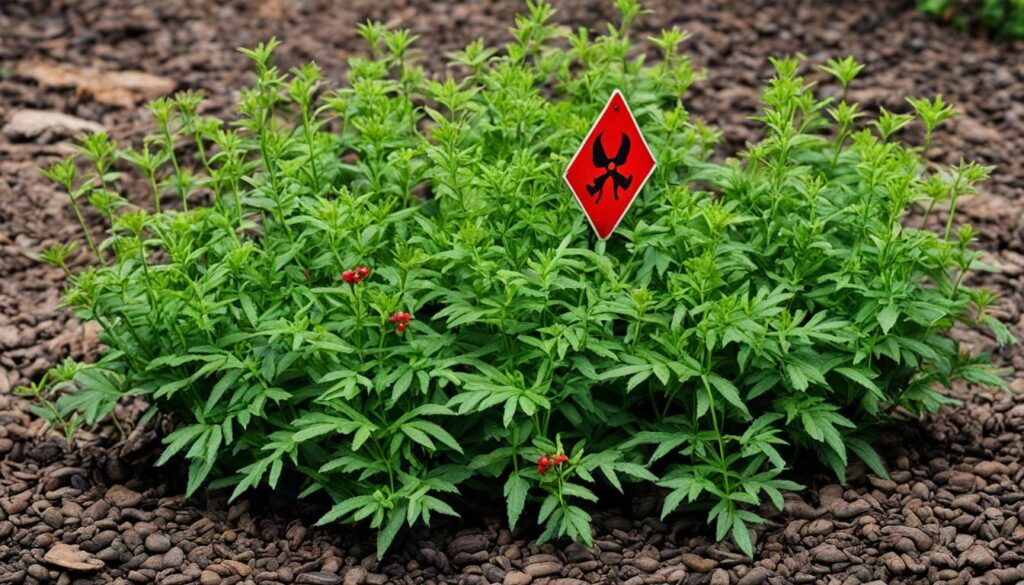
While madder root offers potential health benefits, it is essential to exercise caution and adhere to proper guidelines when using it. Here are some important tips and precautions to keep in mind:
- Avoid madder root during pregnancy: Madder root has historically been known to stimulate menstrual flow and may potentially cause miscarriage. It is advisable to refrain from using madder root in any form during pregnancy.
- Avoid madder root while breastfeeding: Madder root can pass into breast milk and may harm the baby. Thus, it is recommended to avoid madder root when breastfeeding.
- Follow dosage instructions: If you plan to take madder root supplements, it is crucial to carefully follow the recommended dosage instructions provided on the product packaging. However, it is always wise to consult with a healthcare professional before starting any new supplement regimen.
- Be aware of potential side effects: Although madder root is generally considered safe when used in moderation, it may cause side effects such as digestive discomfort or allergic reactions in some individuals. If you experience any adverse reactions, discontinue use and seek medical advice.
“Remember to consult with a healthcare professional before using madder root for any medicinal purposes.”
By following these tips and precautions, you can use madder root safely and responsibly, minimizing potential risks and maximizing its potential benefits.
Potential Precautions and Dosage Instructions for Madder Root
| Potential Precautions | Dosage Instructions |
|---|---|
| Avoid during pregnancy | Consult a healthcare professional for guidance |
| Avoid while breastfeeding | Consult a healthcare professional for guidance |
| Follow recommended dosage instructions | Refer to the product packaging and consult with a healthcare professional |
| Be aware of potential side effects | Discontinue use and seek medical advice if adverse reactions occur |
It is important to prioritize your health and well-being when using any herbal supplement, including madder root. As with any dietary change or new regimen, it is advisable to consult with a healthcare professional before incorporating madder root into your routine.
Selecting and Storing Madder Root
When it comes to choosing madder root, quality is key. It is essential to select high-quality sources to ensure the best results. Look for reputable brands or suppliers that offer organic and sustainably sourced madder root. This ensures that you are getting a product that is not only effective but also environmentally friendly.
One convenient way to use madder root is in powder or extract form. This makes it easy to incorporate into various recipes and applications. Whether you are dyeing fabrics, creating natural food coloring, or making personal care products, having madder root in a powdered or extract form provides versatility and convenience.
Proper storage is crucial for maintaining the potency and quality of madder root. To keep it fresh for longer, store it in an airtight container. This prevents exposure to air, moisture, and light, which can degrade its effectiveness. A dark, cool cupboard or pantry is an ideal storage location for madder root.
Conclusion and Final Thoughts on Madder Root Uses
Throughout history, madder root has proven to be a versatile and valuable resource, offering benefits in natural dyeing, medicinal applications, and more. Its vibrant red color has made it a sought-after natural dye in the textile industry, giving fabrics a rich and long-lasting hue. From silk to cotton to leather, madder root has played a significant role in creating beautiful and sustainable colors.
Not only is madder root a natural dye, but it also boasts medicinal properties. Its anti-inflammatory effects have made it a traditional remedy for joint pain and arthritis, while its diuretic properties promote cleansing and detoxification. Madder root is even believed to aid in wound healing, making it a valuable ingredient in topical applications.
Whether you’re a textile enthusiast, a skincare aficionado, or someone seeking alternative medicinal remedies, madder root has much to offer. However, it’s important to approach madder root use with caution. Thorough research, consultation with professionals, and responsible usage are essential to ensure its safe and effective utilization.
With its rich history, vibrant colors, and potential health benefits, madder root continues to be a celebrated and valuable ingredient in various industries and daily routines. So, whether you’re exploring the world of natural dyeing, looking to enhance your skincare routine, or seeking natural remedies, consider incorporating madder root into your lifestyle for its numerous uses and benefits.
FAQ
What is madder root?
Madder root, also known as Rubia tinctorum, is a plant that has been used for centuries as a natural dye and medicinal herb.
What are the historical uses of madder root?
Madder root has a long and rich history in the textile industry, where it has been used as a natural dye for fabrics such as silk, wool, cotton, and leather.
What are the medicinal properties of madder root?
Madder root has anti-inflammatory and diuretic properties. It has been traditionally used to help with joint pain, redness, swelling, arthritis, and wound healing.
How is madder root used in culinary applications?
Madder root is used as a natural food coloring, adding a vibrant red hue to various dishes and beverages, including desserts, drinks, and savory dishes.
How is madder root used in personal care products?
Madder root is used in skincare products for its antioxidant and anti-inflammatory effects. It is also used in natural hair dyes as a plant-based alternative to synthetic dyes.
What are some household and other topical uses of madder root?
Madder root can be used to create natural dyes for crafts and fabric dyeing. It can also be added to bath salts and bath bombs for a natural coloring effect.
What are the benefits and application methods of madder root?
Madder root offers potential benefits such as anti-inflammatory properties and purifying effects on the blood and lymph nodes. It can be used orally as capsules or tinctures and topically as creams or oils.
What are the tips and cautions for using madder root?
Madder root should be used cautiously, avoiding during pregnancy and breastfeeding. It is essential to follow dosage instructions and consult with a healthcare professional.
How do I select and store madder root?
Select high-quality, organic, and sustainably sourced madder root. Store it in an airtight container, away from sunlight and moisture, to maintain its potency and quality.
What are the uses and benefits of madder root?
Madder root is used as a natural dye, in medicinal applications, culinary creations, personal care products, and household crafts. It offers potential benefits such as anti-inflammatory properties, support for reproductive health, and natural coloring effects.






